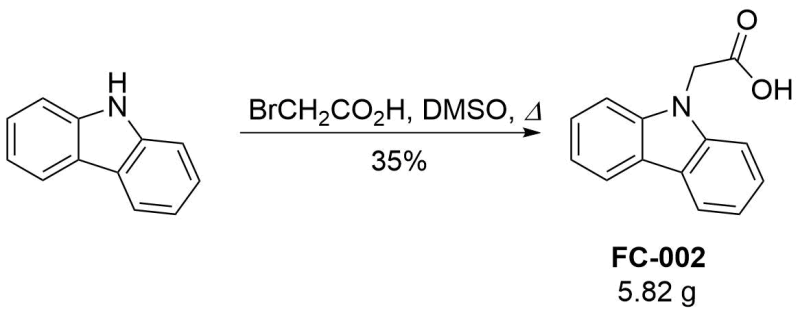Nucleophilic substitution of bromoacetic acid with carbazole
SyntheticPage 925
Submitted: April 29, 2020, published: May 4, 2020
Authors
Bart Dietrich (bart.dietrich@yahoo.co.uk)
A contribution from

Chemicals
Bromoacetic acid (Fluorochem)
Sodium hydroxide (Fisher)
Dimethylsulfoxide (Fisher)
Concentrated hydrochloric acid (Fisher)
Procedure
Carbazole (12.3 g, 73.6 mmol), and crushed sodium hydroxide (3 eq, 8.83 g) were combined in DMSO (50 mL) and heated at 85 °C for 30 minutes. Bromoacetic acid (1.2 eq, 12.3 g) was then added carefully in small portions. The reaction mixture was stirred at 85 °C overnight. The heat was turned off and water (200 mL) was added to the still hot reaction mixture which resulted in a white precipitate. After cooling to room temperature the bulk of the precipitate was centrifuged off while the remainder was filtered off. The precipitate is very fine and tends to clog filter paper so initial centrifugation is required. Concentrated hydrochloric acid (approx 1 eq, 12 mL) was added to the filtrate and the thick white precipitate was stirred for 1 hour. It was then filtered and washed thoroughly with water in the filter. Suction drying then drying by azeotropic distillation with acetonitrile afforded the title compound as a white solid (5.82 g, 35 %).
Author Comments
- The precipitate forming upon addition of water to the hot reaction mixture is very fine and clogs filter paper. Centrifugation is therefore preferred over filtering the initial precipitate. Instead of centrifugation, gravity sedimentation is also an option.
- Concerns about hydrolysis of the filter paper by the strongly basic reaction mixture turned out to be unfounded. The NMR of the final material did not show any impurities resulting from this process. Glass-fibre filters may be used instead of paper filters.
- A blue/purple colour is occasionally generated when adding acetonitrile in the final drying step. The reason for this unknown but it does not affect the NMR of the final compound.
Data
dH (400 MHz, DMSO-d6) 13.00 (1H, COOH), 8.15 (2H, d, J 7.74, HAr), 7.55 (2H, d, J 8.20, HAr), 7.45-7.41 (2H, m, HAr), 7.23-7.20 (2H, m, HAr), 5.22 (2H, s, CH2). dC (100 MHz, DMSO-d6) 170.26 (C=O), 140.50, 125.74, 122.29, 120.19, 119.13, and 109 27 (CAr), 44.00 (CH2). HRMS (ESI) m/z: [M+Na]+ calcd for C14H11NNaO2 248.0682; found 248.0674.
Lead Reference
Keywords
aromatics/arenes, carbazole, carboxylic acids, heterocyclic compounds, nucleophilic, substitution